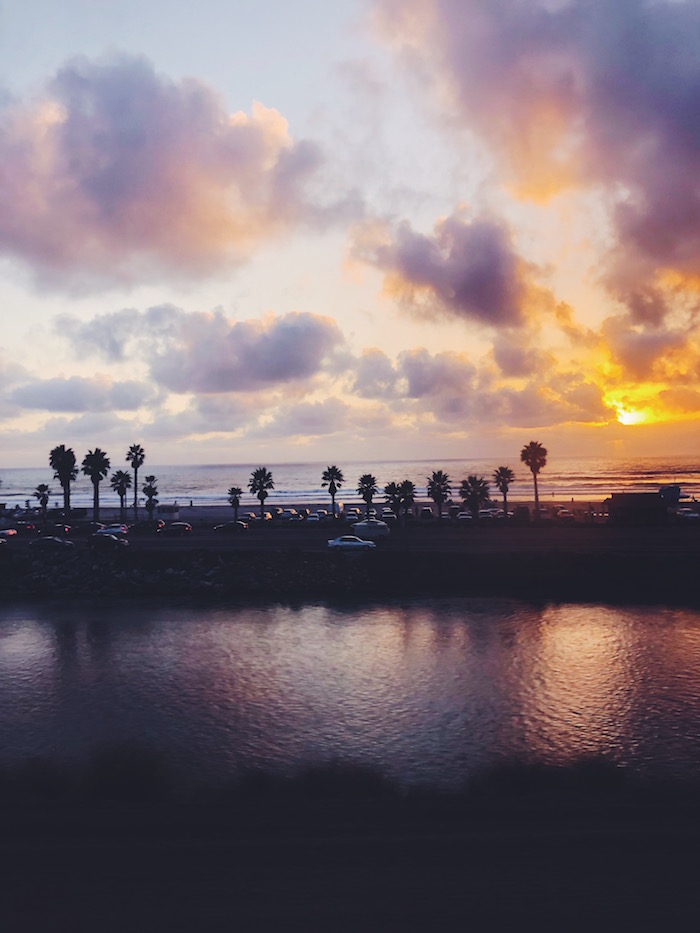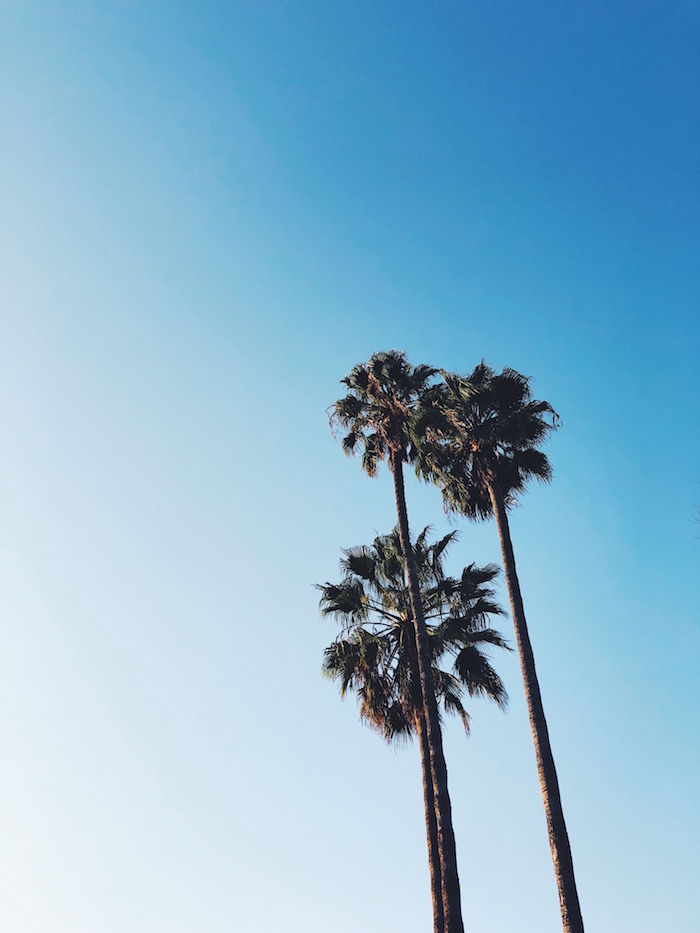A guide to Tokyo for first-timers
Without a doubt, Tokyo is one of the most incredible cities I’ve ever visited–but oh man, it is overwhelming! It’s a enormous, sprawling city with an eclectic mix of neighborhoods and a seemingly endless list of things to do and places to eat and views to see. One of the things I had to come to terms with early on was that we weren’t going to be able to see everything in five days: we would likely barely scratch the surface of recommendations.
Even though the weather didn’t quite cooperate (fun fact: September is typhoon season in Japan), we still managed to fit a lot into our time there. I also feel like we laid a really good foundation for our next trip and got a good sense of the city–because, of course, I’m already plotting on how I can get back (ideally during cherry blossom season)! If it’s your first trip to Tokyo, here are some of the best things we discovered to do, eat and drink in the city, as well as the most common questions we were asked.
What to do
Senso-Ji is the oldest and most colorful Buddhist temple in Japan, and also one of its most visited. Although it’s definitely possible to get temple fatigue after a long trip to Japan, I was still very moved by every one that we visited: not only were they beautiful, but it was also so lovely to see so many people paying their respects. Definitely recommend going early to avoid the crowds!
Shibuya Crossing is probably one of the most iconic locations of modern Tokyo: rumored to be the busiest intersection in the world, hundreds (and sometimes more than a thousand!) people cross at every change of the light. It’s exhilarating to experience on the ground and mesmerizing to watch from above.
On one of the rare sunny days we experienced, we took the loveliest walk through Yoyogi Park. It was full of Japanese families enjoying their Saturday, which made it super fun for people watching. My favorite part was the section of the park reserved for little kids learning how to ride bikes: it was a giant flat track underneath towering shade trees, and it was connected to a little bike rental place with bikes of all sizes. And, of course, I made sure to spy a couple of pugs in the dog park!
Another lovely place to take a seat and stroll was Kiyosumi Garden: I could have easily spent the whole afternoon reading a book in the sunshine here.
Meiji-Jingu is one of the most popular Shinto shrines in Tokyo, and it’s located right next to Yoyogi Park. Amidst all of the towering trees and general feeling of tranquility, it feels like a completely different world than the rest of Tokyo. One thing to note: it looks like it’s in the same park BUT it’s not actually connected. There is good signage to announce where you need to go in the park to find the entrance for the shrine, but know that it’s not as easily connected as it looks on Google Maps.
We sort of stumbled over Hie Shrine, but I’m so glad that we did! It was a beautiful shrine and it was fun to watch all of the dressed-up families taking fancy portraits. There’s also a vivid tunnel of red torii gates tucked away on one of the entrances!
Before we went to Japan, I told David I wanted to visit an onsen and he told me: “I just don’t want to be surrounded by hundreds of naked Japanese men.” And then I tricked him into going to Thermae-Yu and he was surrounded by naked Japanese men he was so glad that I did! I absolutely love going to spas, especially in different countries, and the Japanese onsen is such a cultural experience. On a rainy day after a long flight, it was especially relaxing to spend a couple of hours soaking in hot tubs and carbonated baths and cold plunge pools and switching to saunas and steam rooms. Although it should be noted: you need to be OK with being completely nude (in same-sex areas) and tattoos are not allowed (although rumor has it you can buy patches to cover them up).
I wish I could say more about the Tokyo Imperial Palace, but it was absolutely pouring when we went there. We saw the iconic iron bridges, and then escaped for lunch warmly inside! On a nice day, I would have loved to have wander around these grounds more.
David is strongly committed to seeing a local sporting event whenever we travel, so we planned a lot of our trip to Japan around seeing a traditional sumo match! Even though we went a bit earlier than the ideal time (the tournaments last all day!), we still really enjoyed it. It’s like no other sport I’ve seen, and I kind of loved how short the matches were: each one only takes a few seconds! It’s actually a little difficult to schedule: the Grand Sumo tournaments happen at different times in different cities in Japan throughout the year. Tickets go on sale a month in advance, and often sell out, so recommend booking in advance whenever possible.
What NOT to do
The two things that were widely recommended that we absolutely hated was the Robot Restaurant and Piss Alley. Robot Restaurant seemed like a giant tourist trap, and it wasn’t cheap! It cost $80 a ticket (my head is still swimming that we paid that much) and we left at the first possible intermission.
Afterwards, we went to Piss Alley: although photogenic, we were really put off by the vibe. Again, it seemed to be majorly geared toward tourists and we poked into one place that reeked of cigarette smoke only to be told there was a $10 cover charge.
Where to eat & drink
First of all, it’s hard to eat badly in Japan–no matter the budget or the type of cuisine. There is SO much good food! One of the things that I definitely dropped the ball on was making a reservation at a fancy place, so we weren’t able to experience the high-end Japanese dining that a lot of people rave about (although going right after buying a house also made that a little less of a priority–hopefully next time!).
Our first meal in Japan was at Asuka, this little ramen spot right down the street from where we were staying. The food was simple and inexpensive, but savory and filling (about $8 for a giant bowl), and the ambiance was casual: there were lots of single patrons pulling up to the barstools to slurp down a meal after work.
And although we didn’t splurge on any crazy sushi, it was delicious no matter where we went. I especially loved the conveyor belt sushi experience! We popped into Katsumidori Seibu Shibuya, tucked away in the top floor of a department store. Just as you imagine, you can pop any dish off the conveyor belt that’s working its way around the restaurant, but you can also order specific dishes or drinks on an iPad on your table and they will come straight to your table on a little train from the kitchen. It’s surprisingly pleasant and efficient–and the quality of the food for the price is a truly great value.
Another favorite was Sushi no Midori: none of the locations take reservations, so it can often be spotted from the line outside. It’s nothing too fancy, but it seems like one of those go-to neighborhood spots for families and groups of friends: the food is good, service is efficient, and the prices are affordable.
Our most memorable meal in Tokyo was actually not sushi, but pizza! The Japanese culture is famed for taking the food crafts from other cultures, and perfecting them: whiskey and (Kobe) beef are probably two of the best examples, but now trendy pizza spots are popping up across Tokyo, and the quality rivals Brooklyn. As soon as you take a seat at Savoy Pizza, you have an up-close view of the chef and the wood-burning oven–and although there are only two pizza options, both of them are simply delicious.
One of our other favorite experiences was at Bar Ishinohana: tucked away in a basement a few blocks south of Shibuya station, it’s an oasis of craft cocktails. The low-lit and extraordinarily quiet bar is famed for its farm-fresh, seasonal ingredients, rotating menu to best feature them and very talented bartenders. We were blown away by the skill that went into every cocktail, but the funniest part was definitely the cheese plate that we ordered: $15 for a plate with a few Saltines, some blue cheese and a couple of slices of cheddar. Ha! Highly recommend the drinks, but I think you can probably skip the food.
Another can’t-miss experience is the a drink at the Park Hyatt. The views were made famous in Lost in Translation, but it’s worth visiting even if you’re not a fan of the movie (I watched it for the first time about a week before we went to Japan!). Opening at 5pm daily, the New York Bar & Grill is home to fancy cocktails and nightly jazz. We were in the area earlier in the day, however, so we opted to rest our feet and have a drink (the green tea is next-level) with the most incredible views in the Peak Lounge.
When it comes to breakfast, I am staunchly American in my views: I need coffee, juice and something carb-like and/or egg-like. I do not do noodles in Asia or lunch meat in Europe, and in general, anything that could be eaten for dinner. So! Although the traditional Japanese breakfast was not for me, I was pleasantly surprised by all of the trendy but also on-point brunch spots in Tokyo. It was one time in my travels where I was particularly grateful for globalization and to recognize some restaurant names from afar! In particular, I loved the bookstore-chic vibe and familiar lemon ricotta pancakes at Bills (one of my favorite breakfast joints in Sydney!), as well as the fresh fruit-granola-yogurt combo at Sarabeth’s (a Manhattan staple) and the intense hot chocolate from City Bakery. And Bondi Cafe felt like a little slice of Australian cafe culture, complete with fruit smoothies, perfectly prepared lattes and avocado toast.
And one more thing that must be done while in Tokyo: spend some yen at the ubiquitous vending machines and the omnipresent convenience stores. I got totally obsessed with the bottled Oi Ocha green tea, and the little seaweed rice balls, chocolate Pocky sticks and wide variety of take-home ramen bowls in 7-11s. One of the nicest things, as always, about staying in a place with a kitchen was being able to pick up some things to snack on so that we didn’t have to go out to eat for every single meal.
Where to shop
For all of the fun souvenirs: I got totally obsessed with Tokyo Hands in Shibuya, which has a little bit of everything over several floors. I especially loved the huge variety of washi tape, the big beauty section with lots of sheet masks to choose from, all of the little massagers and reflexology accessories, and the high-end pet accessories and outfits. You can totally get lost in here in the best possible way!
For video games: David looked like a kid in a candy store as soon as we walked into Super Potato in Akihabara. I’ve never really been into games, buuuuut this place is pretty fun! David was stoked to bring home a Nintendo 64 and a few of the games he loved in his childhood (for reference, he spent about $80 total there and the games that he found are going for around $300 on eBay!). Akihabara is a pretty trippy district, full of glowing lights and a million crazy gaming stores.
For books and magazines and records, Daikanyama T-Site is an absolute dream. It’s this gorgeous concept store complete with a bar and cafe, set in this leafy park-like complex (that also has a Leica store and fancy pet shop). It feels like Japan is keeping print in business, especially when it comes to all of these gorgeous coffee table books and a million varieties of dog magazines.
For all of the beautiful things: the Isetan department store flagship in Shinjuku is the perfect place to browse (or splurge) on all of clothes and home goods. Pro tip: the basement food hall has endless Western and Japanese specialities to choose from, and the rooftop has a city view, place for kids to run around and spot to grab food and beers.
Where to stay
One of the things I recommend is booking accommodation early! I definitely slacked in this regard, and by the time I got around to it, there were very limited options (compounded by the fact that it was a national holiday weekend). This is the cute little Airbnb apartment we stayed in: it was located a few blocks south of Shibuya Crossing in a quiet residential neighborhood. p.s. if you haven’t tried Airbnb yet, here is a code for $40 off your first Airbnb stay!
How to get around
The subway is surprisingly easy to navigate (especially with the help of Google Maps!) and affordable (usually around $2-3 a ride, depending on the length). One thing that can be tricky is that there are actually two different subway systems in the city (Tokyo Metro and Toei Subways), and they’re often in the same station with ticket stations not too far from each other–so you need to pay extra attention to what type of tickets you’re buying and what the line is. I’m pleased to say we only made this mistake once!
The bus system is also comfortable and efficient, although the ticket price can be a bit higher (especially if it’s a short ride!). Be prepared to pay when you board in exact yen, although they often have a change maker next to the ticket machine.
We also found the city extremely walkable. We loved wandering through the parks and along the little canals and popping into shops or cafes, and enjoyed seeing how the neighborhoods change from old to new and back again.
FAQ’s
How easy is it to travel in Tokyo without speaking Japanese?
If you speak English: it’s not too bad. If you don’t speak English: it might be tougher. The subway station signs are in English, as well as the instructions at the ticket machines–and the announcements on the train are often in English too! No matter what the restaurant, they always had an English menu. And although many people will speak some English, definitely be prepared to break out a lot of arigato‘s, bows and smiles. Politeness goes a long way!
Any tips on traveling to Tokyo on a budget?
Use public transportation and walk as much as possible–taxis and Ubers here are super expensive. Check out the basement food halls in train stations and department stores for some excellent food options at a fraction of the price of a sit-down restaurant. The convenience stores are also a great spot to pick up super cheap eats! You can also pick up beers and canned mixed drinks in the convenience stores for pretty cheap (and be warned that when it says strong on the can, it is STRONG!). Activities like admiring the shrines or people watching in the park are a wonderful and also free way to experience local culture. It’s definitely an easy place to splurge if you want to, but it’s not as crazy expensive as I expected.
Is it better to plan all your activities in advance or is it worth leaving time to just wander?
Tokyo is a city that loves reservations. If there is a particular activity that you are interested in (say, a sumo match or a baseball game), definitely book tickets well in advance. Same goes for restaurants, especially ones that are fancy or trendy: many are small with limited seatings, so reserve as soon as possible.
Did you feel safe?
I honestly don’t think I’ve ever felt safer in any city. TRULY. Tokyo has regularly been named one of the world’s safest cities, and it was easy to see why. Although I obviously still recommend taking common sense precautions, I felt extremely safe in every neighborhood at every time of day.
Do I need a lot of cash?
More than you might think! I feel like Japan has a reputation for being super tech-savvy, so I was expecting to be able to use my credit card just about everywhere–that’s not the case! You’ll need to have yen to buy subway and bus tickets, and many casual restaurants, vending machines and food stalls are cash-only.



























































